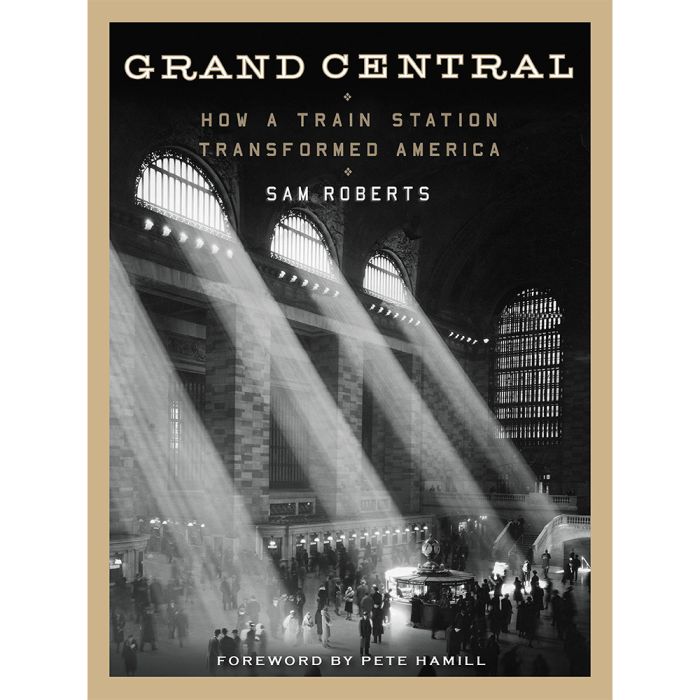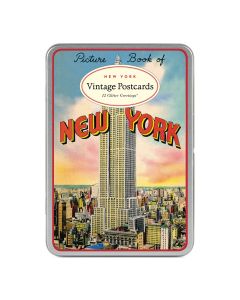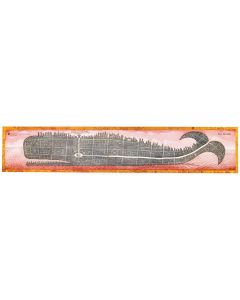Main image
Click to view image in fullscreen

![]()

Grand Central: How a Train Station Transformed America Book
A rich, illustrated - and entertaining -- history of the iconic Grand Central Terminal, from one of New York City's favorite writers, just in time to celebrate the train station's 100th fabulous anniversary.
In the winter of 1913, Grand Central Station was officially opened and immediately became one of the most beautiful and recognizable Manhattan landmarks. In this celebration of the one hundred year old terminal, Sam Roberts of The New York Times looks back at Grand Central's conception, amazing history, and the far-reaching cultural effects of the station that continues to amaze tourists and shuttle busy commuters.
Along the way, Roberts will explore how the Manhattan transit hub truly foreshadowed the evolution of suburban expansion in the country, and fostered the nation's westward expansion and growth via the railroad.
Featuring quirky anecdotes and behind-the-scenes information, this book will allow readers to peek into the secret and unseen areas of Grand Central -- from the tunnels, to the command center, to the hidden passageways.
With stories about everything from the famous movies that have used Grand Central as a location to the celestial ceiling in the main lobby (including its stunning mistake) to the homeless denizens who reside in the building's catacombs, this is a fascinating and, exciting look at a true American institution.
In the winter of 1913, Grand Central Station was officially opened and immediately became one of the most beautiful and recognizable Manhattan landmarks. In this celebration of the one hundred year old terminal, Sam Roberts of The New York Times looks back at Grand Central's conception, amazing history, and the far-reaching cultural effects of the station that continues to amaze tourists and shuttle busy commuters.
Along the way, Roberts will explore how the Manhattan transit hub truly foreshadowed the evolution of suburban expansion in the country, and fostered the nation's westward expansion and growth via the railroad.
Featuring quirky anecdotes and behind-the-scenes information, this book will allow readers to peek into the secret and unseen areas of Grand Central -- from the tunnels, to the command center, to the hidden passageways.
With stories about everything from the famous movies that have used Grand Central as a location to the celestial ceiling in the main lobby (including its stunning mistake) to the homeless denizens who reside in the building's catacombs, this is a fascinating and, exciting look at a true American institution.
In stock
SKU
1-5024
$18.99
Description / Grand Central: How a Train Station Transformed America Book
A rich, illustrated - and entertaining -- history of the iconic Grand Central Terminal, from one of New York City's favorite writers, just in time to celebrate the train station's 100th fabulous anniversary.
In the winter of 1913, Grand Central Station was officially opened and immediately became one of the most beautiful and recognizable Manhattan landmarks. In this celebration of the one hundred year old terminal, Sam Roberts of The New York Times looks back at Grand Central's conception, amazing history, and the far-reaching cultural effects of the station that continues to amaze tourists and shuttle busy commuters.
Along the way, Roberts will explore how the Manhattan transit hub truly foreshadowed the evolution of suburban expansion in the country, and fostered the nation's westward expansion and growth via the railroad.
Featuring quirky anecdotes and behind-the-scenes information, this book will allow readers to peek into the secret and unseen areas of Grand Central -- from the tunnels, to the command center, to the hidden passageways.
With stories about everything from the famous movies that have used Grand Central as a location to the celestial ceiling in the main lobby (including its stunning mistake) to the homeless denizens who reside in the building's catacombs, this is a fascinating and, exciting look at a true American institution.
In the winter of 1913, Grand Central Station was officially opened and immediately became one of the most beautiful and recognizable Manhattan landmarks. In this celebration of the one hundred year old terminal, Sam Roberts of The New York Times looks back at Grand Central's conception, amazing history, and the far-reaching cultural effects of the station that continues to amaze tourists and shuttle busy commuters.
Along the way, Roberts will explore how the Manhattan transit hub truly foreshadowed the evolution of suburban expansion in the country, and fostered the nation's westward expansion and growth via the railroad.
Featuring quirky anecdotes and behind-the-scenes information, this book will allow readers to peek into the secret and unseen areas of Grand Central -- from the tunnels, to the command center, to the hidden passageways.
With stories about everything from the famous movies that have used Grand Central as a location to the celestial ceiling in the main lobby (including its stunning mistake) to the homeless denizens who reside in the building's catacombs, this is a fascinating and, exciting look at a true American institution.
What's The Story
| Grand Central Terminal opened to the public at 12:01 am on February 2, 1913 following a decade of construction. The imposing building, designed by the architectural firm Reed & Stem in collaboration with Warren & Wetmore, resembled a classical monument with oversized columns, large arched windows and detailed ornamentation. Grand Central was the realization of Cornelius Vanderbilt's dream for a grand depot uniting New York's long distance trains with local transit. Built in the Beaux Arts style, it houses one of the nation's most extraordinary interiors with Tennessee marble floors and Botticino marble details crowned by a vaulted ceiling that arches over the 80,000 square foot Main Concourse. The famous astrological mural, originally painted by the Hewlett-Basing Studio, dramatically depicts the October-to-March constellations of the zodiac on a cerulean blue sky. The 2,500 gold-leaf stars, 59 of which have been enhanced in brilliance with fiber optic illumination, glitter in golden splendor upon more than 750,000 visitors each day. |









